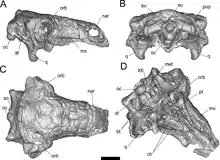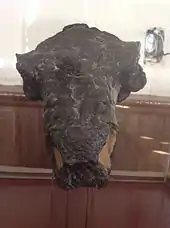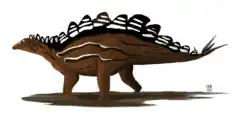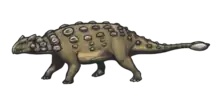| Pawpawsaurus Temporal range: Early Cretaceous (Albian), | |
|---|---|
 | |
| Skull in side, top, back and bottom views | |
| Scientific classification | |
| Domain: | Eukaryota |
| Kingdom: | Animalia |
| Phylum: | Chordata |
| Clade: | Dinosauria |
| Clade: | †Ornithischia |
| Clade: | †Thyreophora |
| Suborder: | †Ankylosauria |
| Family: | †Nodosauridae |
| Subfamily: | †Nodosaurinae |
| Clade: | †Struthiosaurini |
| Genus: | †Pawpawsaurus Lee, 1996 |
| Species: | †P. campbelli |
| Binomial name | |
| †Pawpawsaurus campbelli Lee, 1996 | |
Pawpawsaurus, meaning "Pawpaw Lizard", is a nodosaurid ankylosaur from the Cretaceous (late Albian) of Tarrant County, Texas, discovered in May 1992. The only species yet assigned to this taxon, Pawpawsaurus campbelli, is based on a complete skull (lacking mandibles) from the marine Paw Paw Formation (Wachita Group).[1]
Discovery
Pawpawsaurus was found in the Paw Paw Formation in Tarrant County, Texas, in May 1992, by Cameron Campbell. A complete skull is the only specimen, from which the binomial was named Pawpawsaurus campbelli. The Paw Paw Formation has produced another nodosaurid, Texasetes pleurohalio (Coombs, 1995), which may prove to be a senior synonym of Pawpawsaurus. This is the only nodosaurid known to have possessed the bony eyelids commonly found in ankylosaurids. The skull of Pawpawsaurus bears some notable similarities to that of Silvisaurus, such as the presence of teeth in the premaxilla and the restriction of the osseous secondary palate to the rostral portion of the palatal region.[1]
Description

Pawpawsaurus was a medium-sized nodosaur measuring 4.5 metres (15 ft) long.[2] It is known from a relatively well preserved and complete skull. The skull is complete enough for a 2016 study to be able to identify and reconstruct the brain, nasal cavities and inner ear of the specimen, and CT scan it to find new anatomical features.[3]
The brain of Pawpawsaurus is very similar to other ankylosaurians, but along with more derived taxa it is most different from Kunbarrasaurus. The brain is 30% of the skull length, very similar to Panoplosaurus, higher than Euoplocephalus, and lower than Kunbarrasaurus. The brain of Pawpawsaurus is 96 millimetres (3.8 in) long and 35 millimetres (1.4 in) wide. The inner ear is also similar to ankylosaurians to the exclusion of Kunbarrasaurus, being 27 millimetres (1.1 in) tall and 15.5 millimetres (0.61 in) wide at the level of the semicircular canals. The nasal cavities of Pawpawsaurus resemble that of Panoplosaurus and Euoplocephalus, although the thin dividing medians are not preserved as they were likely cartilaginous.[3]
Classification
Vickaryous et al. (2004) have stated that "Sauropelta edwardsorum, Silvisaurus condrayi, and Pawpawsaurus campbelli form a basal polytomy nested deep to Cedarpelta."[4] Alternatively, Pawpawsaurus has been identified as a relative of Struthiosaurus, with cladogram below showing the results of the 2018 phylogenetic analysis of Rivera-Sylva and colleagues, resolving Pawpawsaurus within the clade Struthiosaurini as labelled by Madzia et al., with relationships outside Struthiosaurini excluded for simplicity.[5][6]
| Struthiosaurini |
| ||||||||||||||||||||||||||||||
However, the strict consensus tree of a phylogenetic analysis performed by Brown et al. (2017) placed Pawpawsaurus in a clade with Borealopelta markmitchelli and Europelta carbonensis. The results of the strict consensus are displayed in the phylogeny below, with taxa outside Nodosauridae being excluded.[7]
| Nodosauridae |
| |||||||||||||||||||||||||||||||||||||||||||||||||||||||||||||||||||||||||||||||||||||||||||||||||||||||||||||||||||||
Palaeobiology
Pawpawsaurus was primitive in regards to its sensory abilities when compared to later ankylosaurs. CT scans of its skull and brain by Paulina-Carabajal and Louis Jacobs et al. revealed that Pawpawsaurus' hearing was on par with that of modern crocodilians, indicating that its hearing was relatively poor. Its sense of smell meanwhile, while not as advanced as that of later ankylosaurs, was still more powerful and acute than many of the theropods existent at the time thanks to its large nasal cavities. The enlarged nasal cavities of Pawpawsaurus would also likely have been useful for cooling blood that was entering the brain, finding food and potential mates, or alerting it to danger.[8]
See also
References
- 1 2 Lee, Y.N. (1996). "A new nodosaurid ankylosaur (Dinosauria: Ornithischia) from the Paw Paw Formation (Late Albian) of Texas". Journal of Vertebrate Paleontology. 16 (2): 232–345. doi:10.1080/02724634.1996.10011311.
- ↑ Holtz, T. R.; Rey, L. V. (2007). Dinosaurs: The Most Complete, Up-to-Date Encyclopedia for Dinosaur Lovers of All Ages. Random House. ISBN 9780375824197.
{{cite book}}: CS1 maint: date and year (link) Genus List for Holtz 2012 Weight Information - 1 2 Paulina-Carabajal, A.; Lee, Y.N.; Jacobs, L.L. (2016). "Endocranial Morphology of the Primitive Nodosaurid Dinosaur Pawpawsaurus campbelli from the Early Cretaceous of North America". PLOS ONE. 11 (3): e0150845. Bibcode:2016PLoSO..1150845P. doi:10.1371/journal.pone.0150845. PMC 4805287. PMID 27007950.
- ↑ Vickaryous, M.; Maryanska, T.; Weishampel, D.B. (2004). "Ankylosauria". In Weishampel, David B.; Dodson, Peter; Osmólska, Halzska (eds.). The Dinosauria (2nd ed.). University of California Press.
- ↑ Madzia, D.; Arbour, V.M.; Boyd, C.A.; Farke, A.A.; Cruzado-Caballero, P.; Evans, D.C. (2021). "The phylogenetic nomenclature of ornithischian dinosaurs". PeerJ. 9: e12362. doi:10.7717/peerj.12362. PMC 8667728. PMID 34966571.
- ↑ Rivera-Sylva, H.E.; Frey, E.; Stinnesbeck, W.; Carbot-Chanona, G.; Sanchez-Uribe, I.E.; Guzmán-Gutiérrez, J.R. (2018). "Paleodiversity of Late Cretaceous Ankylosauria from Mexico and their phylogenetic significance". Swiss Journal of Palaeontology. 137: 83–93. doi:10.1007/s13358-018-0153-1. S2CID 134924657.
- ↑ Brown, C.M.; Henderson, D.M.; Vinther, J.; Fletcher, I.; Sistiaga, A.; Herrera, J.; Summons, R.E. (2017). "Supplemental Information: An Exceptionally Preserved Three-Dimensional Armored Dinosaur Reveals Insights into Coloration and Cretaceous Predator-Prey Dynamics". Current Biology. 27 (16): 2514–2521.e3. doi:10.1016/j.cub.2017.06.071. hdl:1721.1/118950. PMID 28781051. S2CID 5182644.
- ↑ "Early armored dinosaur from Texas lacked cousin's club-tail weapon, but had a nose for danger".

